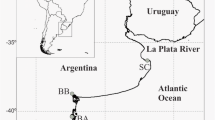Abstract
To quantify disturbance to salt marsh vegetation, and to test the notion that disturbance and species richness are related, we studied disturbance of vegetation by 195 wrack mats that had become stranded over Great Sippewissett Marsh. The mats varied in area, thickness, residence time, and elevation of stranding. Mats that were large, that had residence times of 3–4 months, and were stranded at higher elevations produced the most damage, ranging from total eradication to a decrease in shoot density of underlying vegatation. Thickness had no effect. About 70% of mats caused no damage, and of those that did, damage was usually 50% or less of the area beneath the mat. Plant species were differentially distributed along the tidal excursion within the marsh, and there were more species (8–9) high in the intertidal range than lower (4–6 species). Vertical distribution of species, species richness, and rate of annual disturbance were not well correlated, although highest and lowest disturbance rates corresponded to highest and lowest species richness. Most of the increases in species richness, however, occurred over a very small range of disturbance, so narrow that it seemed unlikely that disturbance affected richness. It seems more likely that factors other than disturbance rate control vertical position of species in salt marshes. It also appears that the effect of disturbance by wrack is less important than has been claimed.
Similar content being viewed by others
References
Bertness MD, Ellison AM (1987) Determinants of pattern in a New England salt marsh community. Ecol Monogr 57:129–147
Chapman VJ (1940) Succession on New England salt marshes. Ecology 21:279–282
Connell JH (1978) Diversity in tropical rain forests and coral reefs. Science 199:1302–1310
Denslow JS (1980) Pattern of species diversity during succession under different disturbance regimes. Oecologia 46:18–28
Hartman JM (1984) The role of wrack disturbance in vegetation of a New England salt marsh. PhD thesis, University of Connecticut, Storrs
Hartman J, Caswell H, Valiela I (1983) Effects of wrack accumulation on salt marsh vegetation. In: Cabioch C, Glemaree M, Samain J (eds) Fluctuation and succession in marine ecosystems. Proceedings of the 17th European Marine Biology Symposium, 1982, Brest, France. Olsen & Olsen, Fredensborg, Denmark, pp 99–102
Levin SA, Paine RT (1974) Disturbance, patch formation, and community structure. Proc Nat Acad Sci USA 71:2744–2747
Lubchenco J (1978) Plant species diversity in a marine intertidal community: importance of herbivore food preference and algal competitive abilities. Am Nat 112:23–39
Miller WR, Egler FE (1950) Vegetation of the Wequetequock-Pawcatuck tidal marshes, Connecticut. Ecol Monogr 20:143–172
Niering WA, Warren RS (1980) Vegetation patterns and processes in New England salt marshes. Bioscience 30:301–307
Nixon SW (1982) The ecology of New England high salt marshes: a community profile. US Fish and Wildlife Service, Division of Biological Services, Washington DC, FWS 10BS-81/55
Paine RT, Levin SA (1981) Intertidal landscapes: disturbance and dynamics of pattern. Ecol Monogr 51:145–178
Reidenbaugh TG, Banta WC (1980) Origin and effects of Spartina wrack in a Virginia salt marsh. Gulf Res. Rep 6:393–401
Roman CT, Niering WA, Warren RS (1984) Salt marsh vegetation change in response to tidal restriction. Environ Manage 8:141–150
Sousa WP (1979) Disturbance in marine intertidal boulder fields: the nonequilibrium maintenance of species diversity. Ecol Monogr 60:1225–1239
Teal JM (1986) The ecology of regularly flooded salt marshes of New England: a community profile. US Fish Wildl Serv Biol Rep 85 (7.4)
Valiela I, Teal JM (1979) The nitrogen budget of a salt marsh ecosystem. Nature 280:652–656
VanBlaricom GR (1982) Experimental analysis of structural regulation in a marine sand community exposed to oceanic swell. Ecol Monogr 52:283–305
Author information
Authors and Affiliations
Rights and permissions
About this article
Cite this article
Valiela, I., Rietsma, C.S. Disturbance of salt marsh vegetation by wrack mats in Great Sippewissett Marsh. Oecologia 102, 106–112 (1995). https://doi.org/10.1007/BF00333317
Received:
Accepted:
Issue Date:
DOI: https://doi.org/10.1007/BF00333317




